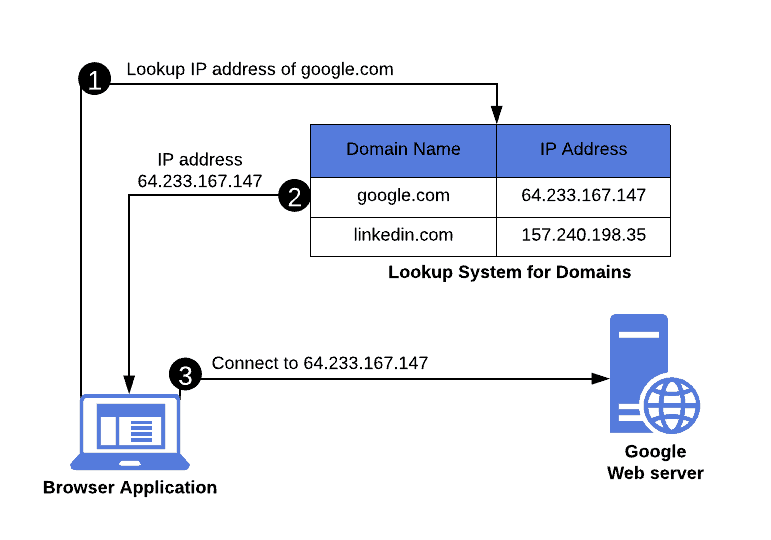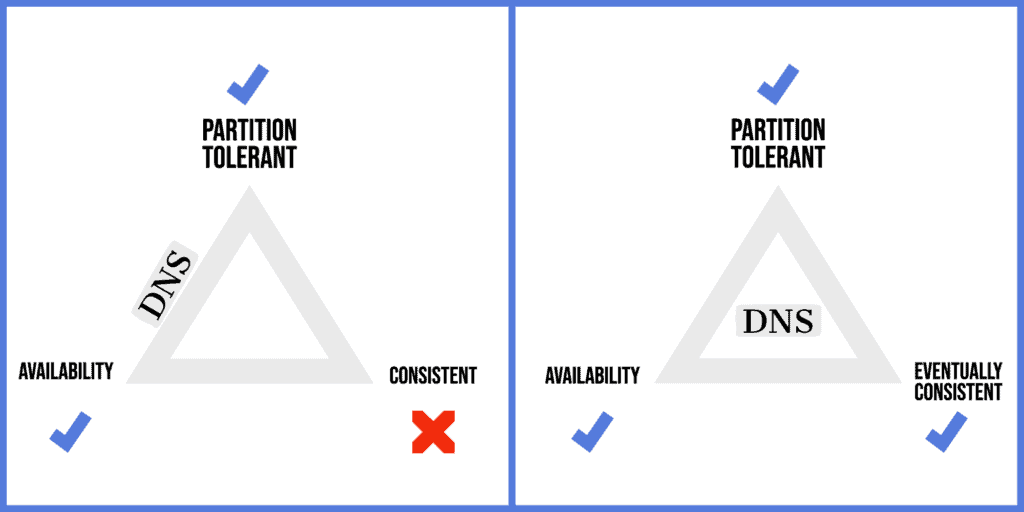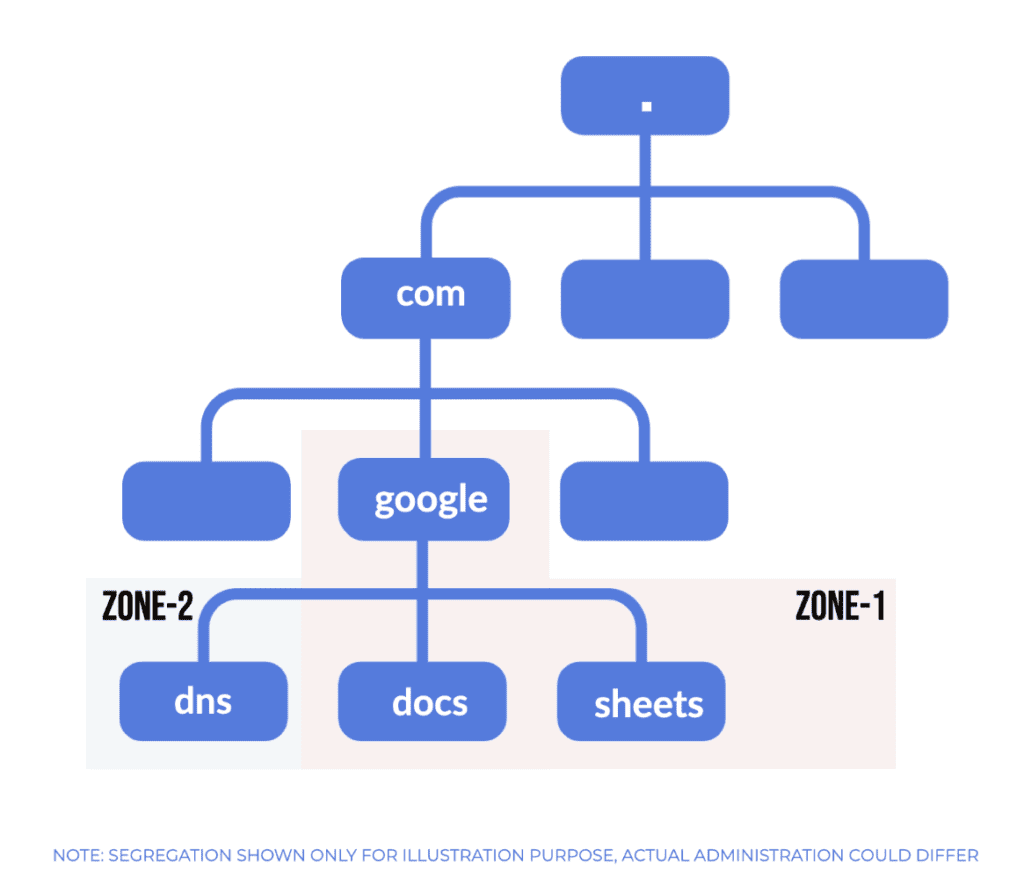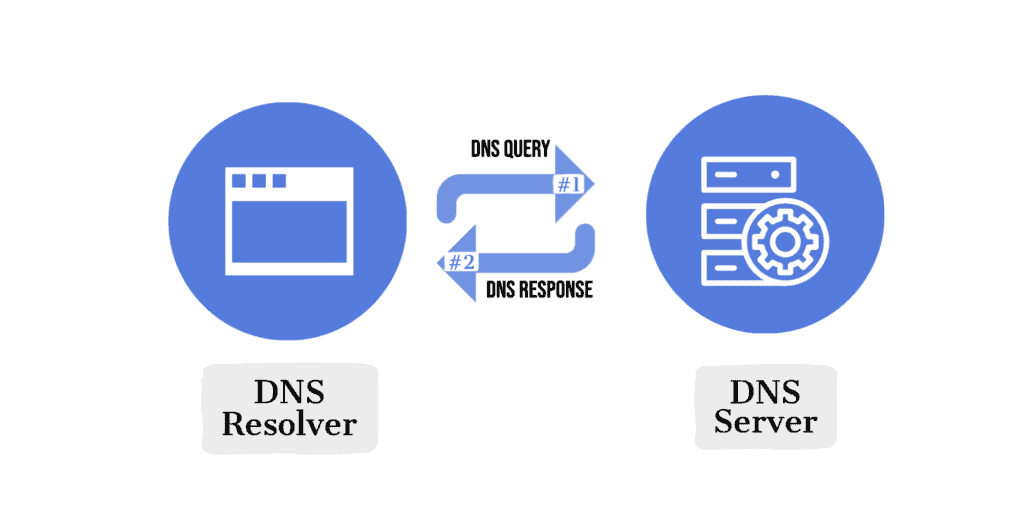1. 简介
IP 地址是互联网通信的基础,但人类更擅长记忆短小的域名而非复杂的数字串。DNS(Domain Name System,域名系统) 就是为了解决这个问题而诞生的。
DNS 的核心作用是:将域名解析为对应的 IP 地址,比如将 google.com 转换为 142.251.42.174。通过本文,我们将系统性地了解 DNS 的基本原理与工作机制。
2. DNS 基础概念
2.1. 域名解析流程
浏览器访问网站时,首先需要通过 DNS 解析域名获取目标服务器的 IP 地址。整个流程如下:
- 浏览器发起 DNS 查询请求
- DNS 服务器查找并返回对应的 IP 地址
- 浏览器使用该 IP 地址连接服务器

由于互联网上活跃的域名数量庞大,每个设备不可能存储全部域名与 IP 的映射关系。因此,DNS 被设计为一个分布式数据库系统,以支持全球范围的高效查询。
2.2. 分布式系统特性
DNS 是一个典型的分布式系统,具备高可用性、最终一致性和一定的容错能力。
根据 CAP 定理,DNS 在网络分区时优先保障可用性,而不是强一致性。这意味着:
✅ 允许短暂的不一致
❌ 无法保证所有节点数据实时同步
⚠️ 但最终会收敛一致

3. 域名空间结构
为了高效管理全球域名,DNS 使用了一种树状层级结构,称为Domain Namespace(域名空间)。
3.1. 层级结构
整个域名空间是一个倒置的树形结构,每个节点代表一个域名。从上到下依次为:
- 根域(Root Domain):最顶层,用
.表示 - 顶级域(TLD):如
.com、.org、.cn等 - 二级域(SLD):如
google.com、baidu.com - 三级域及子域(Subdomain):如
mail.google.com、docs.google.com
这种结构使得域名易于组织和管理。
3.2. 完全限定域名(FQDN)
从任意域名节点向上追溯到根域,就构成了该域名的完全限定域名(Fully Qualified Domain Name,FQDN),例如:
docs.google.com.(注意结尾的点表示根域)
FQDN 是 DNS 内部使用的完整路径,具有以下命名限制:
- 只能包含字母、数字和连字符(a-z, A-Z, 0-9, -)
- 不能以连字符开头
- 总长度不超过 255 字符,每段不超过 63 字符
3.3. 区域(Zone)
Zone 是 DNS 管理的基本单位,代表由同一台 DNS 服务器管理的一组域名记录。
例如:
google.com、docs.google.com、sheets.google.com由同一台服务器管理,构成一个 Zonedns.google.com由另一台服务器管理,构成另一个 Zone

Zone 可以是主域,也可以是子域,后者称为从属区域(Subordinate Zone)
4. DNS 客户端-服务器架构
DNS 本质上采用客户端-服务器架构:

- 客户端发起查询请求(DNS Resolver)
- 服务器返回解析结果
但实际流程比图示复杂得多。由于域名数据分布在全球多个服务器上,通常需要多级递归查询才能获取最终答案。
5. 域名服务器(Name Server)
Name Server 是 DNS 的核心组件,负责存储域名与 IP 的映射信息。
5.1. 权威服务器(Authoritative Name Server)
这类服务器由管理员配置,保存某个 Zone 的权威数据,是解析的最终来源。
DNS 服务器按层级排列:
- 根服务器(Root Server):全球 13 组,管理根域
- TLD 服务器:如
.com、.net的服务器 - 域服务器:如
google.com的服务器
5.2. 缓存服务器(Caching Name Server)
为了提高解析效率,DNS 引入了缓存机制。缓存服务器可以:
✅ 减少对权威服务器的查询压力
❌ 存在缓存过期导致的不一致风险
缓存的有效期由 TTL(Time To Live)控制。TTL 由权威服务器设置,缓存服务器据此决定何时刷新数据。
6. DNS 解析流程
6.1. 递归与非递归查询
DNS 支持两种查询方式:
| 类型 | 说明 |
|---|---|
| 递归查询 | 客户端要求服务器返回最终答案 |
| 非递归查询 | 服务器可以返回答案或推荐下一个查询的服务器 |
解析流程如下:
- 客户端向本地 DNS 缓存服务器发起递归查询
- 缓存服务器向根服务器发起非递归查询
- 根服务器返回 TLD 服务器地址
- 缓存服务器继续向 TLD 服务器查询
- TLD 返回权威服务器地址
- 缓存服务器最终向权威服务器获取 IP 地址
- 结果返回客户端

6.2. 转发器与递归器
DNS 服务器类型:
- Forwarder(转发器):将查询请求转发给其他 DNS 服务器
- Recursor(递归器):自己完成整个解析过程
大多数公共 DNS 服务(如 Google Public DNS 或 Cloudflare 1.1.1.1)都是递归服务器。
7. DNS 资源记录(Resource Records)
DNS 不仅能解析域名到 IP,还支持多种资源记录类型,用于不同用途:
| 类型 | 用途 |
|---|---|
| A | IPv4 地址 |
| AAAA | IPv6 地址 |
| CNAME | 别名记录,指向另一个域名 |
| MX | 邮件服务器地址 |
| NS | 指定该域名的权威 DNS 服务器 |
| SRV | 服务发现记录,包含主机名和端口,常用于微服务架构 |
例如,SRV 记录可用于服务发现:
_service._proto.name. TTL class SRV priority weight port target
8. 总结
通过本文,我们了解了 DNS 的核心概念与工作原理:
- DNS 是一个分布式数据库系统
- 域名空间采用树状结构组织
- 域名解析依赖递归与非递归查询机制
- 权威服务器与缓存服务器协同工作
- DNS 支持多种资源记录类型,适应不同场景
理解 DNS 的工作机制,有助于我们更好地进行网络故障排查、性能优化和系统设计。
